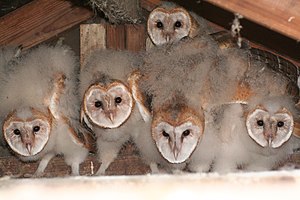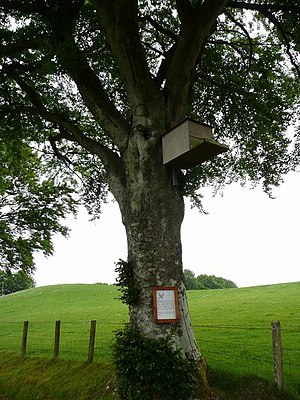
Barn Owls live in barns and similar buildings, often around farms. Unfortunately because of their close proximity to the use of pesticides on farms, they often face the danger of secondary poisoning.
As farmers use these chemicals to kill rodents the owls (and other animals) that eat those rodents are also poisoned and die a slow death as the toxins build up in their system. Rodents have the habit of becoming immune to a pesticide, and the solution is often to invent/use another pesticide instead of finding a better solution, and the damaging cycle continues.
The Adirondack Wildlife Refuge and Rehabilitation Center and other organizations are trying to work with farmers to raise awareness of this issue and of the usefulness of owls! They are trying to get farmers to work with Barn Owls instead of inadvertently killing them.

Owls are great hunters because of their excellent hearing and ability to fly silently. During mating season (about 6 months of wooing, mating, and caring for fledglings) a barn owl family can eat about 3,000 rodents!
Also, the mere presence of predators in an area has an effect on rodents, and that pressure (prey mentality) limits their movements. Instead of relying on poisons and toxins that will damage the environment farmers can partner with owls to lower the rodent population.
How to Build a Barn Owl Nest Box

If your farm does not have any Barn Owls, or you want to attract more, then you can install a Barn Owl box on your property!
“Barn owls are cavity nesting birds of prey but they do not create their own nest holes. Instead, they frequently use cavities from other birds or hollow trees, and they readily move into nest boxes. With the right nest box, it is possible to encourage barn owls to become permanent residents.” (Barn Owl Nest Boxes)
You can purchase already made Barn Owl nest boxes and set them up around a farm to attract these owls. With a Barn Owl box you can improve your rodent control naturally.
You can also build your own Barn Owl box. Follow these printable instructions to build a nest box most likely to attract the owls’ attention. Take into consideration the warnings and guidelines about where to place the boxes and how to build them to ensure a safe nest box.
For example, the entrance hole must be an appropriate size for a Barn Owl to enter, but not large enough for a Great-horned Owl or Raccoon (natural predators of the Barn Owl). Many other things must be considered as well.
“Observing nesting barn owls can be a rewarding and exciting experience, and choosing [or making] the right barn owl nest box and positioning it appropriately will encourage these ghost owls to [stay & return].” (Barn Owl Nest Boxes)
Visit The Barn Owl Trust to learn more about these birds and protecting them.
Related articles



Leave a Reply